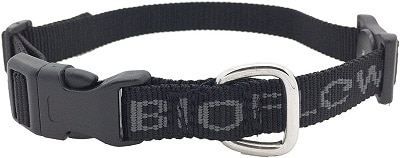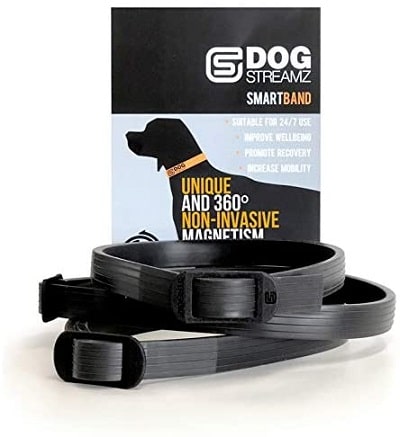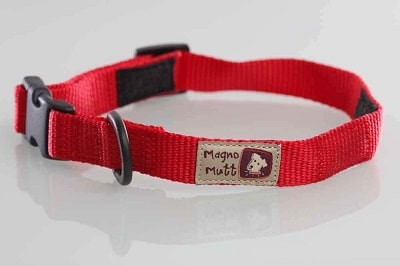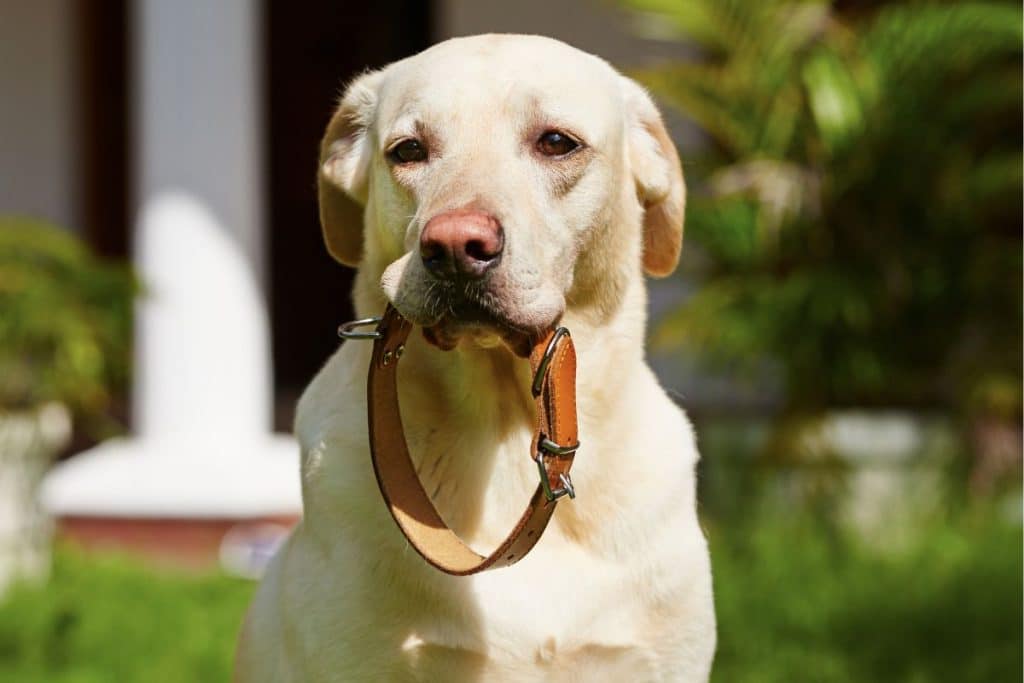It’s a terrible time seeing your dog suffer from arthritis or other similar joint and muscle problems. Unfortunately, the disease has no cure and will sadly worsen over time.
However, plenty of therapies, medicines and products can alleviate the pain and stiffness to help slow the progress and give them some respite. One of these products designed to help ease the discomfort is magnetic dog collars.
Magnetic therapy proponents believe these fields can stimulate circulation, reduce inflammation, and promote healing in dogs.
If you already know what a magnetic dog collar is, you can jump straight to my handpicked collars for you to choose from. If not, let’s continue.
What’s a magnetic dog collar & how does it work?
Magnetic dog collars have gained popularity among pet owners seeking alternative methods to improve their dogs’ quality of life. They’re designed with embedded magnets that emit low-level magnetic fields.
They operate on the principle of magnetic therapy, which is based on the belief that certain magnetic fields can positively impact the body.
Magnetic therapy has been used for centuries in human medicine and has also gained popularity in veterinary care. It offers pain relief (due to analgesic properties), reduced inflammation, improved circulation, and reduced stress.
Best Magnetic Dog Collars of 2023
1. Bioflow Dog Collar

The Bioflow Dog Collar is the best magnetic dog collar in the UK, retailing at £27.94. The exterior is made of durable nylon canvas, ensuring long-lasting use. It uses a powerful “central reverse polarity” magnet inside. The collar is non-invasive, lightweight and stylish.
The positive experiences shared by customers further reinforce the effectiveness of the Bioflow Dog Collar.
It’s important to note that the Bioflow Dog Collar is not intended as a restraining collar but a non-invasive therapy tool. It’s advisable to continue using your existing collar or harness during walks while keeping the Bioflow collar on at all times.
Read More: How To Train Your Puppy To Wear A Collar In One Week
2. DOG Streamz magnetic smart band

Using “360 resonance technology”, this smart-looking collar can (according to StreamZ) relieve aches and pains by having the magnet spin instead of pulse.
StreamZ points out that the product is most effective for dogs to wear while exercising, such as walking and running. Its only con is that DOG Streamz is even more expensive than Bioflow.
3. Magno Mutt – Advanced Magnetic Dog Collar

The Magno Mutt collar is superior to the other products as it has larger magnets (their words, not ours) to provide natural pain relief to dogs suffering from arthritis.
It’s a plain-looking, non-intrusive, and lightweight product that won’t weigh down your dog’s neck.
Magnetic Dog Collar Buyer’s Guide
After much thought, I came up with 7 aspects of a magnetic dog collar that you must check to choose the best. Let’s begin!
1. Size and Fit
Selecting a properly fitting collar prevents discomfort, skin irritation, and potential injuries. It also allows the magnetic therapy to be applied correctly.
To determine the right size, measure your dog’s neck circumference using a soft tape. Ensure it is snug but tight enough. Refer to the manufacturer’s size chart for the appropriate collar size.
2. Material and Durability
Magnetic dog collars are typically made of nylon, leather, or neoprene. Nylon is durable, easy to clean, and suitable for most dogs. Leather collars are stylish and durable but require more maintenance. Neoprene is lightweight, comfortable, and suitable for sensitive skin.
Look for collars with reinforced stitching, sturdy hardware, and high-quality materials. Consider the durability of the chosen material, especially if your dog is active or prone to chewing.
3. Strength and Number of Magnets
The strength of the magnets should match the specific condition you’re targeting. Consult your veterinarian or a magnetic therapy specialist to determine the appropriate strength based on your dog’s size, health, and condition.
4. Type of Magnetic Therapy
Different types of magnetic therapy are available for dogs, each with benefits and applications.
Static magnets, pulsed electromagnetic field therapy (PEMF), and alternative therapies like acupuncture and acupressure are commonly used for dogs. Each type works differently and may have varying effects.
Consult your veterinarian or a qualified practitioner to determine the most suitable type of magnetic therapy for your dog’s condition.

5. Style and Design
Consider your dog’s personality and style when selecting a magnetic dog collar. While functionality is important, there’s no reason why your dog’s collar can’t also be fashionable.
Read More: A Beginner’s Guide to Best Dog Collar Cameras UK 2023
6. Additional Features
Look for collars with adjustable straps, quick-release buckles, and strong D-rings for leash attachment. These features ensure a secure and comfortable fit for your dog and make it easier for you to handle them during walks or outdoor activities.
Consider a magnetic collar with reflective stitching if you often walk your dog during low-light conditions. This feature increases your dog’s visibility and safety, making them more visible to motorists and pedestrians.
Some magnetic dog collars have built-in ID tag holders or attachment points for additional accessories like charms or lights.
7. Price and Value
Set a budget for the collar based on your financial means. Magnetic dog collars are available in a wide price range, depending on the brand, materials, and additional features. Consider the average price range and find a collar that fits your budget.
Can it help with the dog’s joint pain problems?
First, here’s an important disclaimer:
Magnetic therapy may not be a medical solution to your dog’s pain. To date, there are no well-designed, large-scale, peer-reviewed studies specifically focused on magnetic therapy for dogs with arthritis. This makes it challenging to draw definitive conclusions about its effectiveness.
A 2007 study on their effectiveness on humans revealed it had no effect. A 1976 study that tried to determine if they worked and helped popularise them again was debunked. Lastly, a 2013 study on copper bracelets also came up with the same conclusion that it was a load of nonsense.
When using magnetic collars for dogs with arthritis or joint problems, it’s important to follow these tips to ensure their effectiveness:
1. Consult a veterinarian: They can evaluate your dog’s condition, provide appropriate recommendations, and guide you on using magnetic collars as part of a comprehensive treatment plan.
2. Choose the right collar: Look for comfortable, adjustable collars made from high-quality materials to ensure a proper fit and long-lasting use.
3. Follow usage guidelines: Adhere to the manufacturer’s guidelines for using the magnetic collar.
4. Combined with other treatments: This may include veterinary-prescribed medications, joint supplements, weight management, and appropriate exercise routines.
5. Monitor your dog’s response: Note any changes in mobility, pain levels, or comfort. Record your dog’s progress to discuss with your veterinarian during follow-up appointments.
Case Studies and Success Stories

There have been anecdotal reports of dogs experiencing positive outcomes when using magnetic collars for arthritis and joint problems. While individual experiences may vary, these case studies and success stories can provide insights into the potential benefits of magnetic collars:
Max, a 10-year-old Labrador Retriever, had been struggling with arthritis in his hips. After using a magnetic collar for several weeks, his owners noticed improved mobility, reduced stiffness, and increased comfort during daily activities.
Bella, a 7-year-old German Shepherd, was diagnosed with elbow dysplasia. Along with traditional treatments recommended by her veterinarian, her owners incorporated a magnetic collar into her care plan. They observed that Bella seemed more active and less reluctant to engage in physical activities.
It’s important to note that case studies and success stories are not scientific evidence.
Read More: Dog Car Seats: 10 Of The Best Car Seats For Your Dog
Frequently Asked Questions (FAQs)
1. Can magnetic collars replace veterinary care for arthritis?
Magnetic collars cannot and should not replace veterinary care for arthritis or other medical conditions. They can be used as a complementary therapy, but it’s important to consult a veterinarian for proper diagnosis and treatment.
2. Are magnetic collars safe for all dogs?
Magnetic collars are generally considered safe for most dogs. However, it’s recommended to consult a veterinarian before using a magnetic collar, especially if your dog has any underlying health conditions or is on medication.
3. How long does it take to see results with magnetic collars?
Some dogs may experience relief within a few days, while others may take several weeks. Consistency in using the collar as directed is key.
4. How do I clean a magnetic dog collar?
In general, gentle handwashing with mild soap and water is recommended, and avoid submerging the magnets in water. It’s best to refer to the manufacturer’s guidelines for cleaning and maintenance.
5. Can my dog wear a magnetic collar all the time?
It’s generally safe for dogs to wear a magnetic collar throughout the day, but removing it during water activities or when the dog is unsupervised is recommended. Consult with a veterinarian if you have concerns or notice any adverse reactions.
6. Are magnetic collars suitable for puppies?
Magnetic collars can be used for puppies, but choosing a collar size that fits properly and allows growth is important. It’s also advisable to consult a veterinarian before using a magnetic collar on a young dog.





Thanks, found the information provided very helpful.